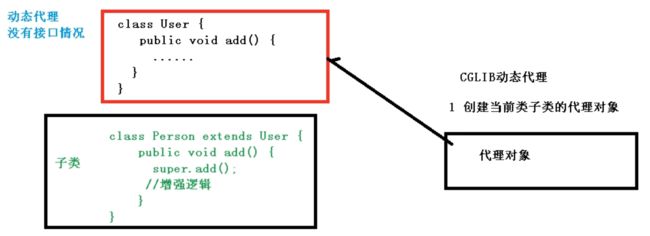Spring5 AOP 学习笔记
尚硅谷-Spring5框架最新版教程(idea版)- AOP P25~P32
AOP底层原理
用动态代理增强类中某个方法的功能
有两种情况的动态代理
1.有接口的情况,使用JDK动态代理:创建接口实现类的代理对象,增强类的方法
 2.没有接口的情况,使用CGLIB动态代理:创建子类的代理对象,增强类的方法
2.没有接口的情况,使用CGLIB动态代理:创建子类的代理对象,增强类的方法

AOP底层原理(JDK动态代理实现)
1、使用JDK动态代理,使用java.lang.reflect.Proxy类里面的方法创建代理对象
该类中有个方法newProxyInstance(ClassLoader loader, Class[] interfaces, InvocationHandler h)返回接口实现类的代理对象
参数loader是 类加载器
参数interfaces是 增强方法所在的类 实现的接口,支持传入多个接口
参数h是 实现接口InvocationHandler,创建代理对象,写增强的方法
2、编写JDK动态代理代码
(1)创建接口 定义方法
public interface UserInterface {
public int add(int a, int b);
public String update(String id);
}
(2)创建接口实现类 实现方法
public class UserImpl implements UserInterface {
@Override
public int add(int a, int b) {
System.out.println("add方法开始执行...");
return a + b;
}
@Override
public String update(String id) {
System.out.println("update方法开始执行...");
return id;
}
}
(3)使用Proxy类创建接口代理对象
public class MyJDKProxy {
public static void main(String[] args) {
// 创建接口实现类的代理对象
Class[] interfaces = {
UserInterface.class};
// // 方式一:匿名内部类
// Proxy.newProxyInstance(MyJDKProxy.class.getClassLoader(), interfaces, new InvocationHandler() {
// @Override
// public Object invoke(Object proxy, Method method, Object[] args) throws Throwable {
// return null;
// }
// });
// 方式二:创建一个类UserInterfaceProxy实现接口InvocationHandler接口
UserImpl userImpl = new UserImpl();
UserInterface userInterface = (UserInterface) Proxy.newProxyInstance(MyJDKProxy.class.getClassLoader(), interfaces, new UserInterfaceProxy(userImpl));
int result = userInterface.add(1, 2);
System.out.println("result:" + result);
}
}
class UserInterfaceProxy implements InvocationHandler {
// 1.创建的是谁的代理对象 就把谁传递过来
// 有参构造传递
private Object obj;
public UserInterfaceProxy(Object obj) {
this.obj = obj;
}
// 增强的逻辑
@Override
public Object invoke(Object proxy, Method method, Object[] args) throws Throwable {
// 方法执行前
System.out.println("方法执行前===传入的方法名称:" + method.getName() + "===传递的参数:" + Arrays.toString(args));
// 被增强的方法执行
Object res = method.invoke(obj, args);
// 方法执行后
System.out.println("方法执行之后===返回结果:" + res);
return res;
}
}
(4)执行MyJDKProxy类中的main()方法
方法执行前===传入的方法名称:add===传递的参数:[1, 2]
add方法开始执行...
方法执行之后===返回结果:3
result:3
AOP操作术语
1、连接点:在一个类中可以被增强的方法
2、切入点:实际真正被增强的方法
3、通知(增强):实际增强的逻辑部分。通知有多重类型(前置、后置、环绕、异常、最终)
4、切面:是个动作,把通知应用到切入点的过程
AOP操作-准备工作
1、Spring框架一般都是基于AspectJ实现AOP操作
AspectJ独立于AOP框架,不是Spring组成部分,一般把AspectJ和Spring框架一起使用,进行AOP操作
2、基于AspectJ实现AOP操作:xml配置文件 或者 注解
3、引入AOP相关依赖
4、切入点表达式
作用:知道对哪个类里面的哪个方法进行增强
语法结构:excution([权限修饰符][返回类型][类全路径][方法名称]([参数列表]))
权限修饰符可以省略(默认public),返回类型不能省略
举例1:对com.shinka.spring5test.UserInterface类里面的add进行增强
excution(* com.shinka.spring5test.UserInterface.add(..)) 注意 中间有个空格
举例2:对com.shinka.spring5test.UserInterface类里面的所有进行增强
excution(* com.shinka.spring5test.UserInterface.*(..))
举例3:对com.shinka.spring5test包里面所有类的所有方法进行增强
excution(* com.shinka.spring5test.*.*(..))
AOP操作-AspectJ注解
1 创建类 在类里面定义方法
public class User {
public void add() {
System.out.println("add..."); }
}
2 创建增强类(编写增强逻辑)
在增强类里面,创建方法,让不同方法代表不同通知类型
public class UserProxy {
public void before() {
System.out.println("before..."); }
}
3 进行通知的配置
(1)在Spring文件中,开启注解扫描
<beans xmlns="http://www.springframework.org/schema/beans"
xmlns:xsi="http://www.w3.org/2001/XMLSchema-instance"
xmlns:context="http://www.springframework.org/schema/context"
xsi:schemaLocation="http://www.springframework.org/schema/beans http://www.springframework.org/schema/beans/spring-beans.xsd
http://www.springframework.org/schema/context https://www.springframework.org/schema/context/spring-context.xsd">
<context:component-scan base-package="com.shinka.spring5test.aopanno">context:component-scan>
beans>
(2)使用注解创建User和UserProxy对象
在User和UserProxy类添加注解@Component
// 被增强的类
@Component
public class User {
public void add() {
System.out.println("add..."); }
}
// 增强的类
@Component
public class UserProxy {
// 前置通知
public void before() {
System.out.println("before..."); }
}
(3)在增强类上面添加注解@Aspect
// 增强的类
@Component
@Aspect // 在增强类上面添加注解@Aspect,让它能够生成代理对象
public class UserProxy {
...
}
(4)在Spring配置文件中开启生成代理对象
<aop:aspectj-autoproxy/>
4 配置不同类型的通知
在增强类(UserProxy)的里面,在作为通知方法上面添加通知类型注解,使用切入点表达式配置
// 前置通知
@Before(value = "execution(* com.shinka.spring5test.aopanno.User.add(..))")
public void before() {
System.out.println("before..."); }
// 后置通知/返回通知。被增强的方法有异常则不执行
@AfterReturning(value = "execution(* com.shinka.spring5test.aopanno.User.add(..))")
public void afterReturning() {
System.out.println("afterReturning..."); }
// 最终通知。不管被增强的方法有无异常,都在方法执行之后执行
@After(value = "execution(* com.shinka.spring5test.aopanno.User.add(..))")
public void after() {
System.out.println("after..."); }
// 异常通知
@AfterThrowing(value = "execution(* com.shinka.spring5test.aopanno.User.add(..))")
public void afterThrowing() {
System.out.println("afterThrowing..."); }
// 环绕通知。被增强的方法有异常则"环绕之后"不执行
@Around(value = "execution(* com.shinka.spring5test.aopanno.User.add(..))")
public void around(ProceedingJoinPoint proceedingJoinPoint) throws Throwable {
System.out.println("around 环绕之前...");
// 被增强的方法执行
proceedingJoinPoint.proceed();
System.out.println("around 环绕之后...");
}
5 测试结果
spring5底层变了之后 通知顺序是:环绕前 - 前置 - afterReturning - 后置 - 环绕后
被增强的方法有异常的话,环绕后、afterReturning不执行、
public class TestAop {
@Test
public void testAopAnno() {
ApplicationContext context = new ClassPathXmlApplicationContext("bean1.xml");
User user = context.getBean("user", User.class);
user.add();
}
}
【运行结果】
around 环绕之前...
before...
add...
afterReturning...
after...
around 环绕之后...
若add()方法内部有异常 执行结果是:
around 环绕之前...
before...
afterThrowing...
after...
6 相同切入点抽取
重用 切入点的定义
// 相同切入点抽取
@Pointcut(value = "execution(* com.shinka.spring5test.aopanno.User.add(..))")
public void pointDemo() {
}
// 直接使用定义的方法名
@Before(value = "pointDemo()")
7 多个增强类对同一方法进行增强,设置增强类优先级
在增强类上面添加注解@Order(数值),数值越小 优先级越高
@Order(1)
public class UserProxy
// 仿照UserProxy新建PersonProxy类
@Order(5)
public class PersonProxy
【运行结果】
User Around 环绕之前...
User Before...
Person Around 环绕之前...
Person Before...
add...
Person AfterReturning...
Person After...
Person Around 环绕之后...
User AfterReturning...
User After...
User Around 环绕之后...